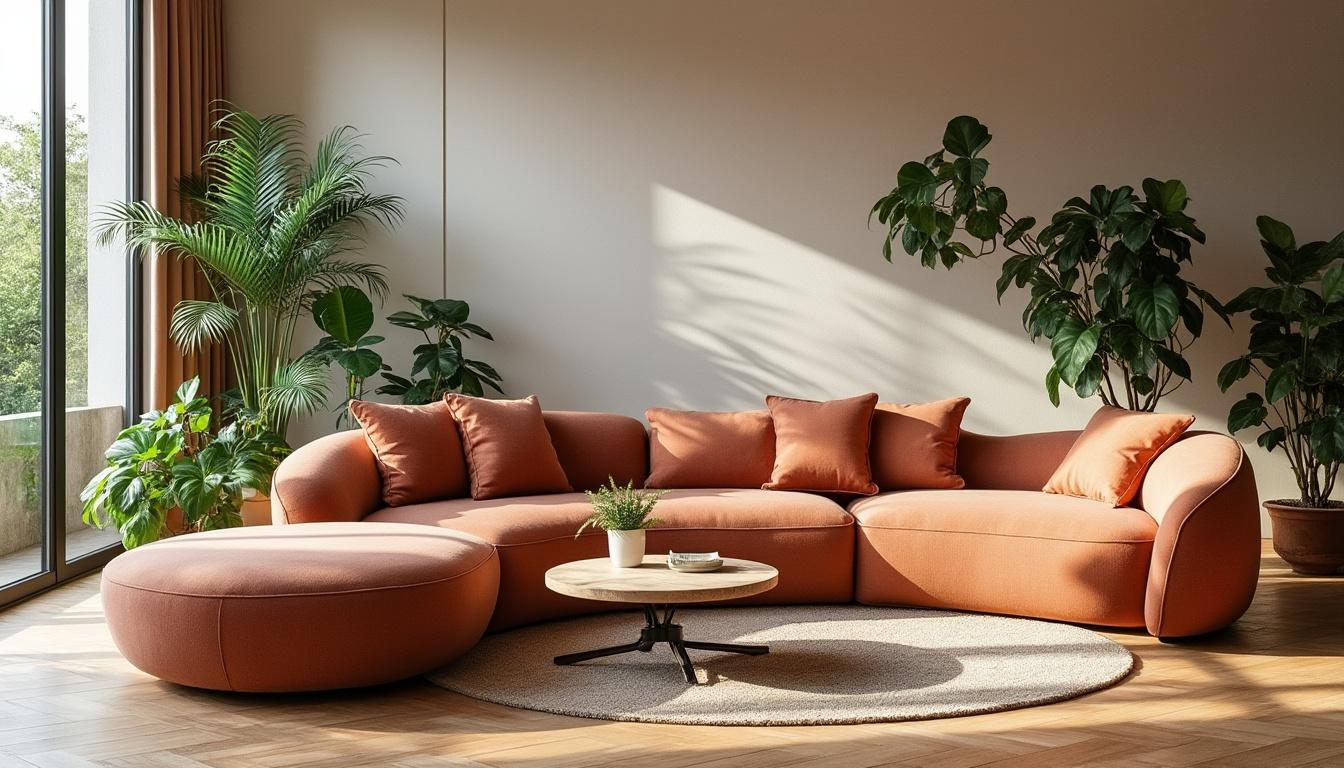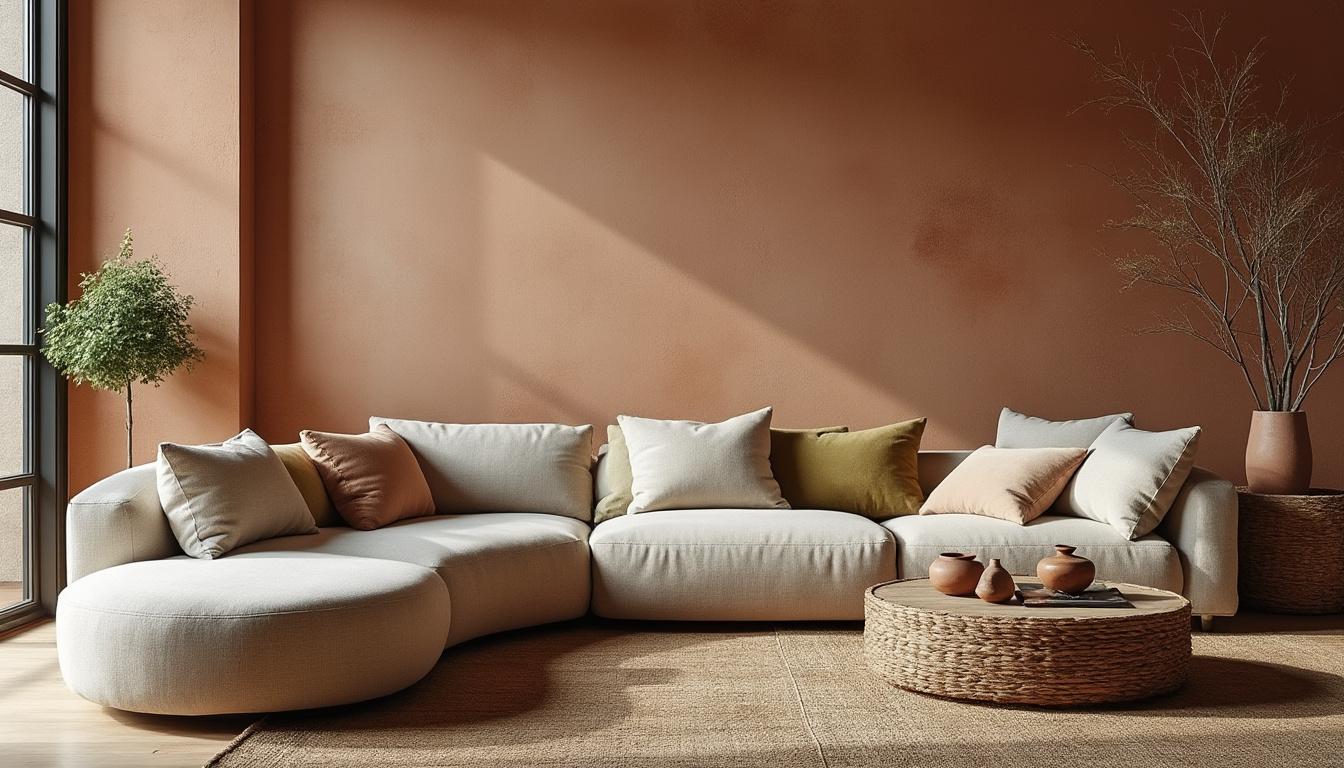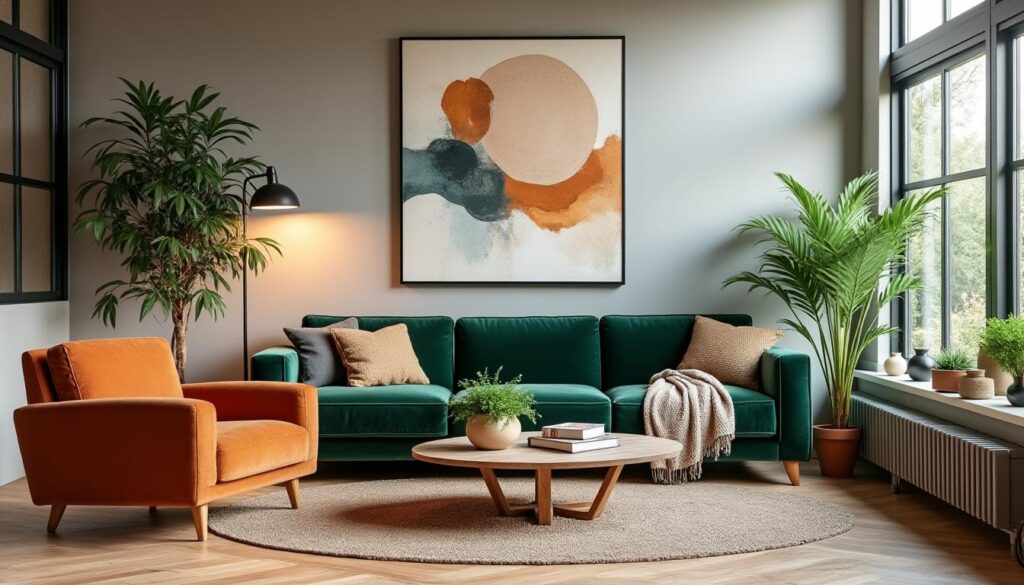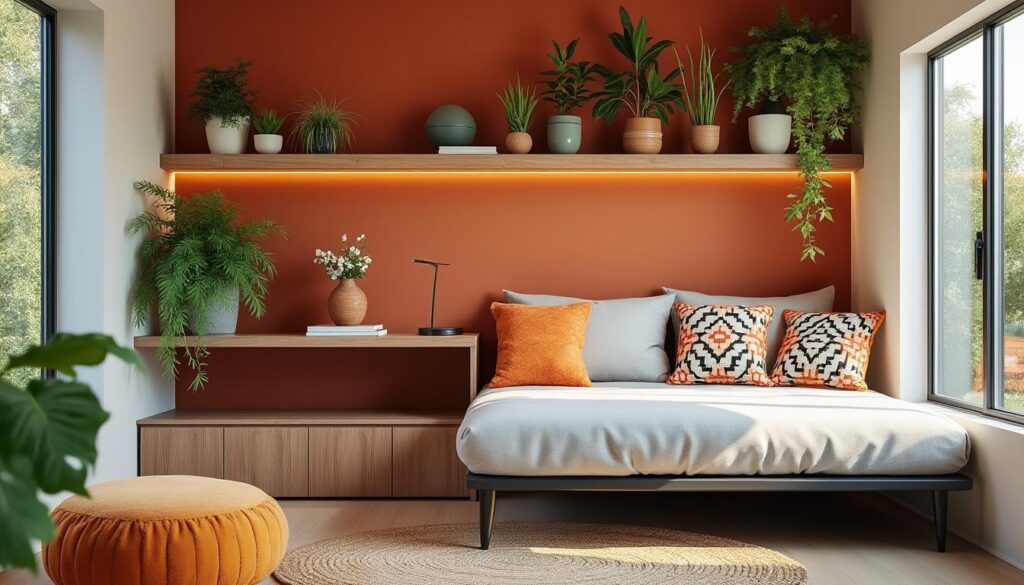The decoration trends that mark this year combine well-being, sustainability, and personality, with easy solutions to apply in any home. The goal is clear: to create beautiful, functional, and planet-friendly spaces without complicating matters.
Short on time? Here’s the essence:
| ✅ Priority | 💡 Practical tip | 🎯 Why it works | ⚡ Quick action |
|---|---|---|---|
| Natural materials | Use reclaimed wood, fibers, and ceramics | Reduces environmental impact and brings coziness | Paint with low VOC paint and replace a rug with sisal 🌱 |
| Biophilia | Include 3 to 5 easy-care plants | Improves air quality and reduces stress | Set up a small vertical garden on the balcony 🪴 |
| Mixing styles | Combine modern with retro or wabi-sabi touches | Creates personality without losing balance | Restore an old piece and make it the focal point 🎨 |
| Multifunctionality | Invest in modular furniture and lightweight dividers | Versatility for real homes | Install a foldable table in the living/office 🧰 |
| Colors and textures | Use earthy tones, greens, and deep blues | Visual comfort and sophistication | Paint an accent wall in olive green 🎯 |

Sustainable decoration trends: natural materials that elevate your space
Decorating with awareness is no longer a niche. Today, materials with low ecological footprint, local production, and durable pieces make up stylish and practical environments. Reclaimed wood, bamboo, linen, hemp, and artisanal ceramics emerge as protagonists, paired with paints that have low VOC content and solutions that favor natural light.
Real example? Marina and João, in an urban T2, replaced the varnished sideboard with a piece of reclaimed wood and swapped synthetic curtains for raw linen. The result was immediate: a warmer atmosphere, a pleasant woody smell, and a feeling of a “breathing” home. With a few changes, the living room gained authenticity and thermal comfort.
How to choose responsible materials without losing style
Smart choices start with the origin and life cycle. Prioritize what is renewable, recycled, or recyclable and check certifications when possible. Maintenance also matters: easy-to-clean surfaces last longer and avoid frequent replacements.
- 🌿 Reclaimed wood: rustic charm and lower resource consumption.
- 🧵 Natural fabrics (linen, organic cotton, hemp): tactile comfort and thermal regulation.
- 🪵 Bamboo: lightweight, sturdy, and versatile for panels and small furniture.
- 🏺 Artisanal ceramics: unique shapes that value handmade items.
- 🎨 Low VOC paints: cleaner air, ideal for bedrooms and living rooms.
When planning, think in layers: the floor provides warmth, the textiles add coziness, and the lighting highlights. A sisal rug, organic cotton cushions, and a wicker lamp can transform the visual reading of the environment without construction.
| Material 🌱 | Recommended use | Environmental benefit | Essential care |
|---|---|---|---|
| Reclaimed wood | Tables, panels, shelves | Avoids new extraction and gives a second life | Natural sealants and gentle cleaning 🧽 |
| Bamboo | Room dividers, lamps, lightweight tops | Fast and renewable growth | Avoid excessive moisture 💧 |
| Linen/organic cotton | Curtains, light upholstery, bedding | Low impact and thermal comfort | Wash with cold water for durability ❄️ |
| Artisanal ceramics | Vases, lamps, decorative objects | Local production and durable pieces | Avoid thermal shocks 🔥 |
| Low VOC paints | Interior walls | Improves air quality | Ventilate well during application 🌬️ |
To start today, replace a centerpiece with a natural material and observe the impact. The eye does not lie: less plastic, more life.
Biophilic decoration trends: plants, natural light, and a sense of refuge
After years of spending more time at home, the connection with nature has taken on a therapeutic role. Biophilia goes beyond “just putting plants”: it involves well-distributed light, ventilation, organic textures, and earthy tones that calm. The result is environments that reduce stress and enhance the sense of well-being.
In a compact apartment, a hollow shelf with pothos plants can separate the living room from the home office without blocking light. In single-story homes, skylights and strategically placed mirrors increase brightness and make the vegetation “vibrant.” The final touch comes from scents: woody essential oils blend with porous ceramics for a subtle fragrance.
Easy and beautiful plants for those with little time
With a busy routine, resilient species are allies. Alternating dark green and silver or variegated tones creates depth. And a golden rule: three heights — ground, furniture, and suspended — provide visual rhythm without cluttering.
- 🪴 Pothos and philodendron: versatile, great for shelves and macramé.
- 🌿 Zamioculca and snake plant: robust, tolerate low light.
- 🌵 Cacti and succulents: require little water, ideal for sunny nooks.
- 🌳 Ficus lyrata (in a bright spot): sculptural focal point.
- 🍃 Ferns: perfect for creating a “green cascade” on balconies.
| Plant 🌱 | Ideal light | Watering | Benefit to the environment |
|---|---|---|---|
| Pothos | Medium indirect | Moderate | Purifies and grows quickly ✅ |
| Zamioculca | Low to medium | Scarce | Resilient and elegant 💪 |
| Snake Plant | Varied | Low | Helps improve air quality 🌬️ |
| Ficus lyrata | High indirect | Regular | Sculptural focal point 🎯 |
| Fern | Medium | Frequent | Volume and visual freshness 💧 |
To avoid mistakes: avoid overwatering and rotate pots every two weeks for even growth. And remember to use felt or cork pads to protect natural furniture.
If you want an accessible refuge, combine plants, light wood, and natural fabrics. This trio transforms the home into a pause space that renews every day.
Mixing styles harmoniously: wabi-sabi, modern retro, and curved furniture
Personality without excess is the motto. The mix of styles — from wabi-sabi to retro reinterpretation — creates unique environments, as long as there is a common thread. The 60/30/10 rule helps: 60% neutral base, 30% textures, and 10% color accents/impact pieces.
In a studio in Porto, an organically curved bouclé armchair contrasts with vintage sideboards with tapered legs. The main wall received sand-colored lime and an original artwork with fluid lines. Pieces with marks of time were kept; instead of hiding, the scars were highlighted — the essence of wabi-sabi: beauty in imperfection.
Tips for combining old and new without “clashing”
Harmony comes from rhythm and repetition. Repeat a color, a wood, or a metal in two or three points and everything connects. Comfort comes from curved lines that break the rigidity of walls: rounded sofas and oval tables facilitate movement and bring people closer.
- 🌀 Strategic curves: a sofa or oval table already softens the environment.
- 🎨 Earthy palette + blue accents: warm neutral with sophistication.
- 🧱 Lime or mineral texture walls: depth without exaggeration.
- 🕯️ Layered lighting: ceiling, table, and wall lights create a cozy atmosphere.
- 📚 Vintage piece as the protagonist: choose one and let it “speak”.
| Combination ⭐ | How to apply | Avoid | Result |
|---|---|---|---|
| Wabi-sabi + modern | Weathered wood + clean sofa | Excess rustic pieces | Balanced authenticity ✅ |
| Retro + minimal | Vintage lamp + smooth walls | Patterns on all surfaces | Focal point with lightness 🎯 |
| Curves + straight lines | Oval table + straight shelves | Only curved pieces | Fluidity and order 🧭 |
| Brushed metal + wood | Brass details + oak | Conflicting shiny metals | Timeless elegance ✨ |
Ana, an illustrator, inherited a mirror from the 80s. Instead of hiding it, she hung it over a minimalist sideboard and repeated the brass in discreet handles. Simple and cohesive. The message is clear: mix with intention, not by chance.

Intelligent multifunctional spaces: modular furniture and invisible technology
Homes that work in your favor require flexibility. Modular furniture adapts to daily use, and invisible technology keeps aesthetics clean. Think of a living room that turns into a home office, a balcony that transforms into a mini-gym, and a kitchen that accommodates friends comfortably.
A solution that works: modular shelves with adjustable niches and hidden cables, a foldable table on the wall, and a sofa with modules that separate to create a “U” during meetings. Behind, an embedded power strip, induction charging on the side of the sideboard, and LED strips with sensors for night lighting.
Automation that doesn’t show (and simplifies the routine)
The secret lies in integration. Dimmers that adjust brightness according to daylight, blinds that respond to pre-programmed scenes (“work”, “rest”, “entertain”), distributed built-in sound, and discreet thermostats create comfort without clashing with the décor.
- 🧩 Modularity: modular sofas, nesting tables, storage poufs.
- 🪄 Hidden cabling: technical conduits and built-in plugs keep everything clean.
- 💡 Scene lighting: work, cook, relax at a touch.
- 🧱 Lightweight dividers: screens, louvered panels, and hollow shelves.
- 🎛️ Voice or app control: practical and accessible daily.
| Challenge 🧩 | Solution | Benefit | Installation tip |
|---|---|---|---|
| Few meters | Retractable table and foldable bed | Frees circulation ✅ | Securely mount on studs 🔩 |
| Cables visible | Conduits and built-in plugs | Clean look ✨ | Plan points before carpentry 📐 |
| Irregular light | Sensors and dimmers | Comfort and efficiency 💡 | Position near windows 🪟 |
| Ambient sound | Built-in speakers | Discrete integration 🎵 | Provide ducts and acoustic blankets 🎧 |
When each element serves more than one function, the house works with you. Prioritize modularity, order, and light — the rest is detail.
Trendy colors, personality walls, and gathering spaces that unite the home
Colors influence mood and focus. This year, the standout colors are earthy tones (clay, terracotta, sand), natural greens (sage, olive, moss), and deep blues (petrol, grayish navy). Walls gain texture with lime, louvered panels, and graphic wallpapers in the right doses.
Marcos and Rita transformed the kitchen into the heart of the home: a multi-use island with a durable top, warm pendant lighting, and sage green cabinets. The artisanal zellige backsplash gave a soft shine, and curved wooden benches invite you to stay. In the bathroom, a “mini spa” with a rain shower, indirect light, and cotton textiles elevated the end-of-day ritual.
How to define a palette without regrets
Test samples at different times of the day. Combine warm with cool for balance, and use the “tone up or down” rule for subtle variations. If the wall is terracotta, a sand rug and olive green cushions create a calm and contemporary ensemble.
- 🟤 Earthy for warmth: perfect in living rooms and bedrooms.
- 🟢 Greens for renewal: ideal in kitchens and workspaces.
- 🔵 Blues for focus: great for home offices and reading rooms.
- 🧱 Textures on the walls: louvered panels, stucco, or raised wallpaper.
- 🖼️ Walls with history: original murals or art arrangements.
| Palette 🎨 | Environment | Safe combinations | Highlight element |
|---|---|---|---|
| Terracotta + sand | Living room/bedroom | Raw linen + light wood | Handcrafted tapestry ✅ |
| Sage green + brass | Kitchen | Light zellige + oak | Pendant over the island ✨ |
| Petrol blue + warm gray | Home office | Sisal rug + walnut table | Geometric artwork 🎯 |
| Moss + natural stone | Bathroom | Indirect light + brushed brass | Rain shower 🌧️ |
For personality walls, a botanical mural in the living room or a louvered panel with backlighting in the hallway changes the entry experience. And in the kitchen, think of gathering: an island or peninsula brings conversations closer and provides a stage for them.
How about an immediate gesture? Paint an accent wall, switch handles for brushed brass, and add a pendant. In just a few hours, your home tells a different story.
Reimagined minimalism: functional, warm, and meaningful
Current minimalism is not cold; it is intentional. Instead of removing for the sake of removing, one selects what matters and creates space to breathe. Simple lines coexist with rich textures, and one or two objects with history make the difference.
In Lisbon, a 48 m² T1 gained amplitude with fewer furniture and more function: compact sofa with storage, extendable bistro table, and wall niches that free the floor. The palette? Sand with olive green accents and original art on just one wall. Result: clean visual, without losing human warmth.
Practical steps for soulful minimalism
Think of curation. If an object has no use or affection, it may need to go. To avoid falling into “emptiness”, introduce textures: wool rug, cotton throw, handmade ceramics. And allow imperfections — a table with marks of time can be your point of greatest character.
- 🧹 Edit without fear: donate or sell what you haven’t used in the last 12 months.
- 🧺 Store beautifully: fiber baskets for throws and magazines.
- 🪑 Less furniture, better furniture: quality wins over quantity.
- 🖼️ Purposeful art: one striking piece says more than several scattered ones.
- 🌗 Soft lighting: lamps and LED strips create cozy layers.
| Principle ✨ | Application | Common mistake | Quick fix |
|---|---|---|---|
| Conscious curation | Select by use and affection | “Empty” minimalism | Add warm textures ✅ |
| Soft palette | Sand, sage, warm gray | Sterile white | Insert earthy tones 🌾 |
| Organic lines | Curved sofas, oval tables | Only right angles | A curved piece as the protagonist 🌀 |
| Hide cables | Conduits and technical furniture | Visual pollution | Built-in plugs 🎛️ |
If you choose well, you need less. Reimagined minimalism is this: clarity with warmth, sobriety with life.
Take a simple gesture today: choose a corner and apply the trio “edit, light, texture.” In minutes, the environment gains soul.
{“@context”:”https://schema.org”,”@type”:”FAQPage”,”mainEntity”:[{“@type”:”Question”,”name”:”What are the decoration colors that most favor well-being?”,”acceptedAnswer”:{“@type”:”Answer”,”text”:”Earthy tones (clay, sand, terracotta), natural greens (sage, olive), and deep blues (petrol, grayish navy) create visual comfort and a sense of calm. Combine a warm with a cool and test samples at different times of the day.”}},{“@type”:”Question”,”name”:”How to apply biophilia in small houses?”,”acceptedAnswer”:{“@type”:”Answer”,”text”:”Use three heights of plants (ground, furniture, suspended), prefer easy species (pothos, zamioculca, snake plant), and maximize light with mirrors. Hollow shelves function as green dividers without blocking light.”}},{“@type”:”Question”,”name”:”Are modular furniture worth it?”,”acceptedAnswer”:{“@type”:”Answer”,”text”:”Yes. They adapt to changes in routine, facilitate organization, and increase versatility. Combine modules with built-in plugs and foldable tables to multiply functions without losing aesthetics.”}},{“@type”:”Question”,”name”:”How to mix retro pieces with a modern base?”,”acceptedAnswer”:{“@type”:”Answer”,”text”:”Choose a retro protagonist piece (lamp, mirror, sideboard), repeat materials or colors in two points, and keep 60% of the space in a neutral base. This way, the ensemble remains cohesive and contemporary.”}},{“@type”:”Question”,”name”:”What quick changes have a big impact?”,”acceptedAnswer”:{“@type”:”Answer”,”text”:”Painting an accent wall, swapping curtains for linen, inserting a pendant over the table, and adding a natural rug. These are accessible interventions that renew the reading of the space.”}}]}What are the decoration colors that most favor well-being?
Earthy tones (clay, sand, terracotta), natural greens (sage, olive), and deep blues (petrol, grayish navy) create visual comfort and a sense of calm. Combine a warm with a cool and test samples at different times of the day.
How to apply biophilia in small houses?
Use three heights of plants (ground, furniture, suspended), prefer easy species (pothos, zamioculca, snake plant), and maximize light with mirrors. Hollow shelves function as green dividers without blocking light.
Are modular furniture worth it?
Yes. They adapt to changes in routine, facilitate organization, and increase versatility. Combine modules with built-in plugs and foldable tables to multiply functions without losing aesthetics.
How to mix retro pieces with a modern base?
Choose a retro protagonist piece (lamp, mirror, sideboard), repeat materials or colors in two points, and keep 60% of the space in a neutral base. This way, the ensemble remains cohesive and contemporary.
What quick changes have a big impact?
Painting an accent wall, swapping curtains for linen, inserting a pendant over the table, and adding a natural rug. These are accessible interventions that renew the reading of the space.


